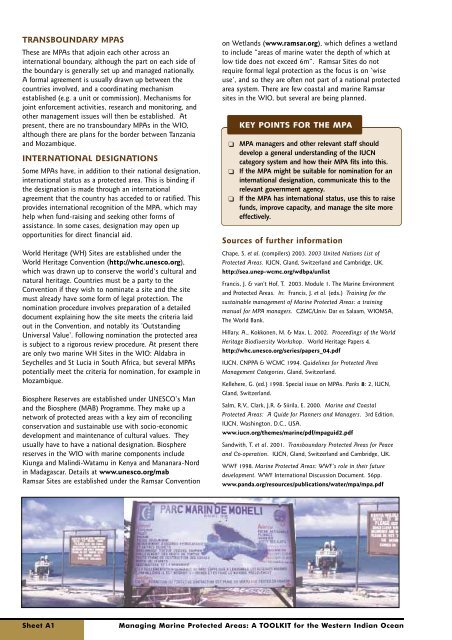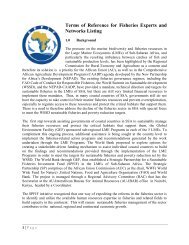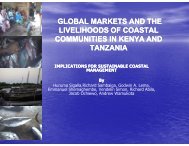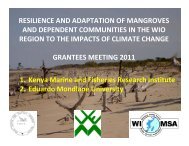Managing Marine Protected Areas Managing Marine Protected Areas
Managing Marine Protected Areas Managing Marine Protected Areas
Managing Marine Protected Areas Managing Marine Protected Areas
Create successful ePaper yourself
Turn your PDF publications into a flip-book with our unique Google optimized e-Paper software.
TRANSBOUNDARY MPAS<br />
These are MPAs that adjoin each other across an<br />
international boundary, although the part on each side of<br />
the boundary is generally set up and managed nationally.<br />
A formal agreement is usually drawn up between the<br />
countries involved, and a coordinating mechanism<br />
established (e.g. a unit or commission). Mechanisms for<br />
joint enforcement activities, research and monitoring, and<br />
other management issues will then be established. At<br />
present, there are no transboundary MPAs in the WIO,<br />
although there are plans for the border between Tanzania<br />
and Mozambique.<br />
INTERNATIONAL DESIGNATIONS<br />
Some MPAs have, in addition to their national designation,<br />
international status as a protected area. This is binding if<br />
the designation is made through an international<br />
agreement that the country has acceded to or ratified. This<br />
provides international recognition of the MPA, which may<br />
help when fund-raising and seeking other forms of<br />
assistance. In some cases, designation may open up<br />
opportunities for direct financial aid.<br />
World Heritage (WH) Sites are established under the<br />
World Heritage Convention (http://whc.unesco.org),<br />
which was drawn up to conserve the world’s cultural and<br />
natural heritage. Countries must be a party to the<br />
Convention if they wish to nominate a site and the site<br />
must already have some form of legal protection. The<br />
nomination procedure involves preparation of a detailed<br />
document explaining how the site meets the criteria laid<br />
out in the Convention, and notably its ‘Outstanding<br />
Universal Value’. Following nomination the protected area<br />
is subject to a rigorous review procedure. At present there<br />
are only two marine WH Sites in the WIO: Aldabra in<br />
Seychelles and St Lucia in South Africa, but several MPAs<br />
potentially meet the criteria for nomination, for example in<br />
Mozambique.<br />
Biosphere Reserves are established under UNESCO’s Man<br />
and the Biosphere (MAB) Programme. They make up a<br />
network of protected areas with a key aim of reconciling<br />
conservation and sustainable use with socio-economic<br />
development and maintenance of cultural values. They<br />
usually have to have a national designation. Biosphere<br />
reserves in the WIO with marine components include<br />
Kiunga and Malindi-Watamu in Kenya and Mananara-Nord<br />
in Madagascar. Details at www.unesco.org/mab<br />
Ramsar Sites are established under the Ramsar Convention<br />
on Wetlands (www.ramsar.org), which defines a wetland<br />
to include “areas of marine water the depth of which at<br />
low tide does not exceed 6m”. Ramsar Sites do not<br />
require formal legal protection as the focus is on ‘wise<br />
use’, and so they are often not part of a national protected<br />
area system. There are few coastal and marine Ramsar<br />
sites in the WIO, but several are being planned.<br />
KEY POINTS FOR THE MPA<br />
❑ MPA managers and other relevant staff should<br />
develop a general understanding of the IUCN<br />
category system and how their MPA fits into this.<br />
❑ If the MPA might be suitable for nomination for an<br />
international designation, communicate this to the<br />
relevant government agency.<br />
❑ If the MPA has international status, use this to raise<br />
funds, improve capacity, and manage the site more<br />
effectively.<br />
Sources of further information<br />
Chape, S. et al. (compilers) 2003. 2003 United Nations List of<br />
<strong>Protected</strong> <strong>Areas</strong>. IUCN, Gland, Switzerland and Cambridge, UK.<br />
http://sea.unep-wcmc.org/wdbpa/unlist<br />
Francis, J. & van’t Hof, T. 2003. Module 1. The <strong>Marine</strong> Environment<br />
and <strong>Protected</strong> <strong>Areas</strong>. In: Francis, J. et al. (eds.) Training for the<br />
sustainable management of <strong>Marine</strong> <strong>Protected</strong> <strong>Areas</strong>: a training<br />
manual for MPA managers. CZMC/Univ. Dar es Salaam, WIOMSA,<br />
The World Bank.<br />
Hillary, A., Kokkonen, M. & Max, L. 2002. Proceedings of the World<br />
Heritage Biodiversity Workshop. World Heritage Papers 4.<br />
http://whc.unesco.org/series/papers_04.pdf<br />
IUCN, CNPPA & WCMC 1994. Guidelines for <strong>Protected</strong> Area<br />
Management Categories, Gland, Switzerland.<br />
Kellehere, G. (ed.) 1998. Special issue on MPAs. Parks 8: 2, IUCN,<br />
Gland, Switzerland.<br />
Salm, R.V., Clark, J.R. & Siirila, E. 2000. <strong>Marine</strong> and Coastal<br />
<strong>Protected</strong> <strong>Areas</strong>: A Guide for Planners and Managers. 3rd Edition.<br />
IUCN, Washington, D.C., USA.<br />
www.iucn.org/themes/marine/pdf/mpaguid2.pdf<br />
Sandwith, T. et al. 2001. Transboundary <strong>Protected</strong> <strong>Areas</strong> for Peace<br />
and Co-operation. IUCN, Gland, Switzerland and Cambridge, UK.<br />
WWF 1998. <strong>Marine</strong> <strong>Protected</strong> <strong>Areas</strong>: WWF’s role in their future<br />
development. WWF International Discussion Document. 56pp.<br />
www.panda.org/resources/publications/water/mpa/mpa.pdf<br />
Sheet A1 <strong>Managing</strong> <strong>Marine</strong> <strong>Protected</strong> <strong>Areas</strong>: A TOOLKIT for the Western Indian Ocean






